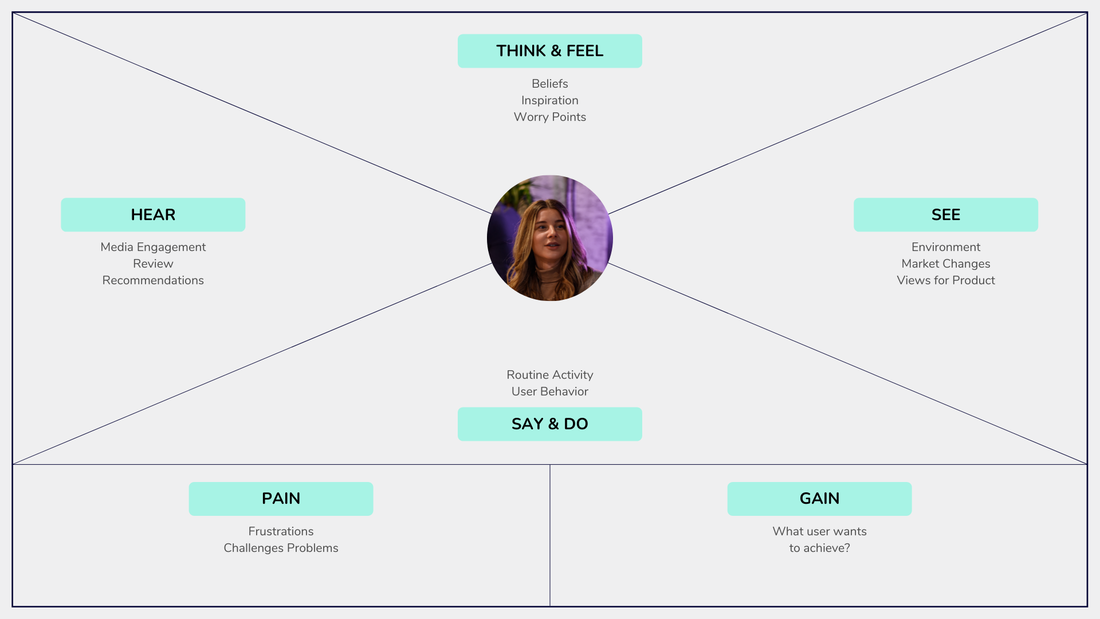What are Empathy Maps and How to Use Them?
Thinking of all that it takes to make a good design can be overwhelming. However, if we dig deeper into good design, we can realize that it is all about people. To design for people, you need to have empathy with them.
It does not matter if you are designing a consumer product or an industrial machine. It also does not matter if you putting together a new business strategy, a new service, or an HR procedure. All those are about people. With this understanding in mind, we can see that the foundation of good design is Empathy.
It does not matter if you are designing a consumer product or an industrial machine. It also does not matter if you putting together a new business strategy, a new service, or an HR procedure. All those are about people. With this understanding in mind, we can see that the foundation of good design is Empathy.
What is Empathy?
Empathy is the ability to understand others’ feelings and problems. In other words, to be able to put yourself in someone else’s shoes. After defining what empathy is, it becomes easy to understand its importance. It is unlikely that we can design good solutions for people without understanding their situation and what they experience.
What are Empathy Maps?
It is much easier to talk about empathy than to establish it. To that end, there are many different tools and methods to establish it. Those range from observations, interviews, diaries, games, lifestyle segmentation, etc. Here, we will introduce one prominent tool referred to as Empathy Map.
An empathy map is a tool that teams can use to gain insight into their stakeholders. In an empathy map, you can put the stakeholder at the center and map out their thoughts, feelings, and actions. It can be used with different stakeholder segments and/or personas.
An empathy map is a tool that teams can use to gain insight into their stakeholders. In an empathy map, you can put the stakeholder at the center and map out their thoughts, feelings, and actions. It can be used with different stakeholder segments and/or personas.
How to Fill an Empathy Map?
You can use an empathy map flexibility based on your needs and situation. For example, you can fill it out quickly as a part of a team exercise or invest more into research for each piece of information. You can also use it lightly to start conversations. The resulting outcome's accuracy and relevance will depend on your investment to construct the map.
The more specific an empathy map is, the more useful it can be. When solving a specific problem, it can help build the map to reflect the user's situation facing that particular problem. For example, assuming we are looking at a learner facing difficulty finding answers to his doubts in a specific situation. The empathy map can highlight the thoughts, feelings, and actions that a person would have or do during that particular situation. Thus, the best way to fill out an empathy map is through interviews and observations. Let us break down each of the quadrants.
To make this easier, let us assume a situation where you are to understand the situation of vegetarian city dwellers maintaining a vegetarian diet.
Those are the main quadrants you will extract from one person through interviews and observations. The last two, Pains and Gains, are areas you can conclude after your analysis and study. They do not have to be explicitly stated by the analyzed person. Let us take a closer look at them:
The more specific an empathy map is, the more useful it can be. When solving a specific problem, it can help build the map to reflect the user's situation facing that particular problem. For example, assuming we are looking at a learner facing difficulty finding answers to his doubts in a specific situation. The empathy map can highlight the thoughts, feelings, and actions that a person would have or do during that particular situation. Thus, the best way to fill out an empathy map is through interviews and observations. Let us break down each of the quadrants.
To make this easier, let us assume a situation where you are to understand the situation of vegetarian city dwellers maintaining a vegetarian diet.
- Think and Feel: here, you can write what makes them worried or happy about their current situation. You can also record what they feel the situation should be. As you would be recording thoughts and feelings, you might not be asking them direct questions like ‘how do you feel about it?’ You can note their spoken tone and behaviors to conclude what they think and feel. Do they think it is challenging to find vegetarian products? Do they feel frustrated about their situation in the city?
- Hear: here, you can record what is being told to the person from their friends and family. You can also include what they hear from influencers they follow or TV programs they watch. Are they being complimented or criticized for being vegetarians? What exactly is being said to them? What do influencers they follow say about being a vegetarian? You can include as many relevant quotes from the participant as plausible.
- See: here, you can describe their physical and digital environment. What websites do they often visit? What social media platform are they in, and what accounts do they follow? What does their physical environment look like? What do they see on offer at the markets they visit?
- Say and Do: for the Say part, you can include quotes from the interviewed person. Do not summarize or interpret what they say, which will add your prejudice to it. You can record the challenges they state as well as desired outcomes or expectations. You can also record any statement you think is insightful. For the Do part, record exactly what they do to face the current challenges as vegetarians. You can also record what they do in things they don’t consider as challenging. For example, if the person you target thinks being vegetarian in the city is easy, you can still record how they find food supplies.
Those are the main quadrants you will extract from one person through interviews and observations. The last two, Pains and Gains, are areas you can conclude after your analysis and study. They do not have to be explicitly stated by the analyzed person. Let us take a closer look at them:
- Pains: here, you can include fears, frustrations, and obstacles the person faces being a vegetarian in the city. For example, it could be that they don’t have enough money to afford a vegetarian diet.
- Gains: here, you can include what the person is ultimately looking for. What are their wants, needs, measures of success, and goals? For example, are they looking to feel good about themselves, support a specific cause, and be part of the effort?
Singular vs. Aggregated Empathy Map
There are two common ways to fill out an empathy map, singular and aggregated. Let us discuss each.
- Singular: You fill out an empathy map for a single person. For example, you would interview and observe a single person and fill out an empathy map just for them.
- Aggregated: You will represent a group of people in a single empathy map. This can be done by combining different singular maps you have from individuals. The aim is to help create trends and themes to work from. When making aggregated maps, a good practice is to separate them based on outlook. For example, people who have a positive outlook on being vegetarians in the city can be put in a different aggregated empathy map to those with a negative outlook.
Conclusion
An empathy map is a powerful tool that provides valuable insights about stakeholders, helping us design solutions that meet their exact needs and desires. By truly understanding individuals' or groups' thoughts, feelings, and actions, we're able to empathize, forge stronger connections, and improve situations for those we serve. This methodology underlies good design, placing people at its heart. If you're intrigued and would like to explore the transformative impact of empathy maps and how can you implement them on your project, we welcome you to contact us and continue the conversation.


